Spotlight: The 14th Century Bascinet
An article by
Alexi Goranov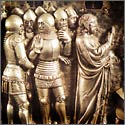
An altar piece in Pistoia Cathedral, Italy, circa 1376, showing soldiers wearing bascinets

"The Romance of Alexander", circa 1340, showing knights wearing bascinets

Stained glass of the Adderbury knight wearing a bascinet
|

The two most characteristic pieces of head protection during the 14th and early 15th century were the kettle hat and the bascinet (also spelled "basinet" or "basnet"). The bascinet was very widely used throughout Western Europe and England and was arguably the more popular type of helmet, at least judging by period illustrations. It was commonly used by both the knightly class and infantry soldiers. There are a number of well-preserved examples in major collections and museums in Europe and the US, as well as many examples depicted on effigies, sculptures, and in period artwork. Many of these effigies, dated throughout the 14th century, show great helms and bascinets together. The memorialized man usually wears the bascinet, while the great helm is held in his hand or placed under his head. These great helms, regularly used during warfare in the 13th century, were mainly relegated to tournament use in the 14th century, especially after 1350. Even though rare depictions of great helms in warfare could be found until the early 15th century, their place as the predominant piece of wartime knightly head protection was overtaken by the bascinet in the 14th century.
Surviving visored bascinets are equally cherished by both collectors and armour students. Despite the availability of resources and the interest, the study of this helmet type is still in its infancy.
Evolution
The 14th century bascinet developed from the steel cap worn under the great helm of the 13th century. These caps were also called bascinets or
cervelliere, though
cervelliere was sometimes used in period literature to mean the lining/padding of helmets. Claude Blair, an authority on arms and armour, tells us that the word "bascinet" came into use at the end of 13th century and was in constant use during the 14th century and into the 15th, after which its use diminished.
Initially the bascinet was worn either over or under the mail coif, in combination with a padded arming cap. When worn under the coif, the bascinet could have given the unnaturally swollen appearance of the heads of knights so often depicted in art and on effigies of the period.
Around 1330, the bascinet became attached to an aventail—a mantle of mail covering the neck and shoulders
1. Small staples called
vervelles facilitated the attachment of the aventail to the bascinet skull. The
vervelles ran along the bottom edge of the helmet and the side edges around the face, thus allowing the aventail to cover the neck, cheeks, and most of the face, exposing only the eyes, nose, and mouth
2. Towards the end of the 14th century, after 1370, the
vervelles were sometimes covered to add decoration, likely with cloth or leather
3. After the beginning of the 15th century, some bascinets were fitted with plate "drapes" instead of the mail aventail, which was still widely popular. A marvelous example survives in the Doge's Palace in Venice. These bascinets were to give rise to the so-called "Great Bascinets" of the 15th century
4.
The shape of the skull of the bascinet underwent steady development during its time of use. The back and sides of the 13th century steel cap extended down to cover just below the ears. This was done to offer better protection when the bascinet was worn by itself. Before 1350 there were three basic shapes:
<LI type=square>Small and globular: covering just below the ears with a round skull5
<LI type=square>Deep and conical: extending all the way to the base of the neck with a conical apex6
- Tall and conical: extending to just bellow the ears, but having a tall conical skull culminating in an elegant point
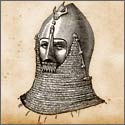 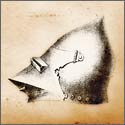   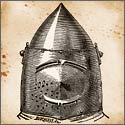  |
Left to right: bascinet with noseguard, ogival-shape with side pivot visor, klappvisor with central pivot visor,
a "great bascinet", a pig-faced visored style, bascinet of Sir John Marmion with covered vervelles
|
After 1350, the tall form developed to reach to the base of the neck and provided more solid protection. The skull was either smooth or had a central ridge on the front running from the apex to the arch above the face. The apex of the skull slowly evolved, moving towards the back. Around 1400, the back-side of the bascinet was almost straight
7. In Germany, the so-called ogival-shape or onion shape became popular, even though there are English effigies with similarly pointed bascinets
8. The standard method of construction of these bascinets was to "raise" them from a single piece of iron. The apexes of some bascinets of the ogival-shape on English effigies are decorated by what appear to be a separate piece of metal
9. Whether the function of this topping piece was anything more than a simple decoration remains to be seen.
Several of the surviving bascinets in the collection at
Churburg Castle have their original inner linings. They were made from wool or canvas filled with cow hair and tied with a cord on the top to allow for size adjustment. The lining was most often attached to the helmet, having been sewn on using small holes drilled on the bottom of the helmet under the holes for the
vervelles. The skulls of the bascinets were often adorned to show the wealth and class of the wearer. Mostly the adornment was a band around the skull
10, but if the person was of high enough rank, a crown was placed atop the bascinet
11. It is hard to tell what material these adornments were made from as no surviving examples exist, but one may speculate that they were made from metal, precious or otherwise. Alternatively, a form of thick padding in the shape of a ring was worn over the bascinet which functioned to support the great helm worn over it
12.
     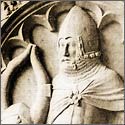 |
Left to right: effigy of Edward, the Black Prince, ob. 1376; monumental brass of Sir John d'Abernon, circa 1340;
monumental brass of Sir Hugh Hastings, circa 1347; brass of Sir William Bagot, circa 1407;
effigy of Kaiser Günther of Schwarzburg, ob. 1349; effigy of Ritter Burkhard von Steinberg, ob. 1379</I>
|
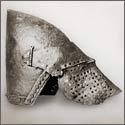
Germanisches Nationalmuseum, Nürnberg
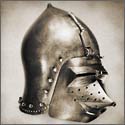
Coburg, Kunstsammlung der Veste
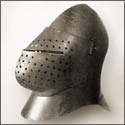
"Great bascinet" from Churburg Castle
|
The Visor
After 1330 the bascinet commonly had some kind of face protection. The simplest kind, popular in Germany and North Italy during 1340-1370, was a triangular piece shaped in three dimensions to accommodate the wearer's nose
13. This protection may have been thickly padded. It was attached centrally to the bascinet by means of hooks or studs on the brow of the bascinet, and it was also tied to the aventail.
The earliest forms of face protection that covered the whole face were oval metal plates with small eye slits and breathing holes. There is a famous surviving example in Sitten, Switzerland. The visor is just large enough to cover the face. It is suspended from a single vertical bar that fits over two studs on the brow of the bascinet. Bascinets with this kind of suspension method are nowadays commonly called
klappvisor bascinets
14.
The visor developed to completely cover the face opening and also developed the characteristic projecting nose cone. This "evolved" visor was attached either by the
klappvisor method or by two hinges on either side of the helmet. The side hinges had removable pins that allowed the visor to be removed when not needed, although for a short period of time, side-pivoted visors were not removable. The
klappvisor bascinets also had an easily removable visor. Both methods of attachment were contemporary, and there are examples of bascinets being fitted from one style of attachment to the other, even though there is no solid evidence that this change had been done during the working time of the bascinet
15.
The characteristicly pointed visor has led current armour students to call this type of bascinet "pig-face" or "hound skull" (from "hundsgugel" meaning hound's hood), but Claude Blair tells us that in contemporary literature they were simply called visored bascinets. The tall conical bascinet fitted with the conical "pig-face" visor was the most common form of the visored bascinet, and was usually referred to as the "International style".
The visors had two eye slits (ocularium, pl. ocularia) and another slit, or slits, at the level of the mouth. There are numerous breathing holes on the right side of the visor, but (in most but not all cases) none or few on the left side. This is consistent with the idea that the opponent's lance was going to strike the left side, so that the bascinet was designed to offer the minimum number of places where the opponent's lance could catch, and likely to also minimize the risk of denting or damaging the visor and subsequently the wearer. The eye slits are usually very narrow (~8mm) to decrease the chance of a weapon getting in. However, it is worth noting that some German visors have wider eye slits
16. Sometimes the slits are crossed with vertical bars to make it even less likely that a weapon could penetrate. Of course, the cost paid was diminished visibility.
Another aspect of the eye slit design is that they were often made to slant diagonally, giving a characteristic grim appearance. One argument put forth to explain this design is that the down-turned eye slits provided much needed downward vision. It is necessary to mention that the eye slits were not always slanted downward and that the degree of slanting varied. On some German examples, the eye slits are virtually horizontal.

From the Historisches Museum, Dresden
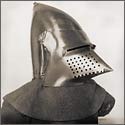
From the Kunsthistorisches Museum, Vienna

From the Churburg Castle, circa 1360
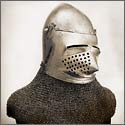
From the Royal Armouries, iv 470
|
Physical Characteristics
Bascinets were widely used throughout Western Europe and were likely made primarily in production centers throughout Europe, e.g. Milan, Venice, etc. The production of
klappvisor bascinets seems to have been limited to Central Europe, even though there are rare references to them in England. Many of the surviving examples of visored bascinets are attributed to either Northern Italy (Milan) or Germany.
Several bascinets have been analyzed from a metallurgical standpoint. One is the visored bascinet in Museum of Valais (MV30-83) that was made in Germany around 1350. The examination revealed heterogeneous steel with no heat-treatment. Another bascinet that was metalurgically tested is the example in
The Wallace Collection (A69). This bascinet was made of low-carbon steel with no heat-treatment. The following are some measurements of this same helmet from The Wallace Collection catalogue:
| Origin: | Northern Italy, Circa 1390-1410 | |

Wallace Collection A69, circa 1390
|
| Overall weight: | 4.065kg (8.96lb) |
| Weight of the skull: | 2.005kg (4.42lb) |
| Weight of the visor: | 0.820kg (1.8lb) |
| Weight of aventail: | 1.24kg (2.7lb) |
| Height: | 26cm (10.25") |
| Visor beak to helmet back: | 37.4cm (14.75") |
Another Northern Italian visored bascinet
17 was determined to have medium carbon content (0.06%). An attempt had been made to harden this bascinet as well. The weight of this bascinet with its visor and aventail is 7.12 kg (15.69lb).
The weight of a bascinet including its visor from
Deutsches Historisches Museum (#35) was recorded at 2.89kg (6.37 lb), with 30cm height, and the skull of another, German one, from the same museum (#32) is recorded at 1.6kg (3.53 lb) and 27cm high.
The Churburg #13 bascinet with its visor and aventail weighs 5.7kg (12.56lb).
The weight of the German bascinet in The Royal Armouries (iv 467) is 1420g (3lb 2oz) for the skull and 455g (1 lb) for the visor. The aventail of this bascinet does not survive.
From these few reported numbers it is obvious that the bascinet varied markedly in size, weight, and manufacture. If considering the weight of only the skull and the visor, here we see a variation from 1857g (4.125 lb) to 2890g (6.37lb). It must be emphasized that we are considering a very limited sample size here and the variation of weights is most likely much greater. As outlined above, the quality of the steel and heat-treatment of the various bascinets varied as well with location and time.
Towards the end of the 14th century as the methodology of producing iron improved, the quality of steel also improved. The heat-treatment of armour pieces to add extra strength also became a usual practice, first in Italy and then in Germany. In support of this theory, Allan Williams states in
Companion to Medieval Armour that most of the tested Italian armour pieces in the Churburg armoury, at least some of which date to the late 14th century, were made of steel and were also heat-treated. One of the earliest known successfully hardened bascinets dates from 1330-1340 and is currently in Milan's Museo Poldi Pezzoli (#2599).
Historic Examples
Brian W. Rainey of the
The Armour Research Society has noted that more than 40 visored bascinets survive. In addition to existing helm and visor combinations, there are also a number of individual visors and helms that display artifacts of visor attachments.
The following is a short list of surviving bascinet examples that the author has managed to trace. Most of them date to the second half of 14th or early 15th century. Inventory numbers are included where known and "?" denotes uncertainty regarding origin:

From the Churburg Castle, circa 1385
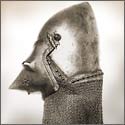
From the Royal Armouries, iv 498
|
<LI type=square>Four in the Metropolitan Museum of Art (29.154.3 Italian; 60.151 Italian; 04.3.238 German; 04.3.241 Italian)
<LI type=square>One on loan to the Los Angeles County Museum from the Metropolitan Museum of Art (29.158.29 German)
<LI type=square>One in the Higgins Armory Museum (HAM# 938 German)
<LI type=square>One in the Wallace Collection (A69 Italian)
<LI type=square>Five in the Royal Armouries (iv 470 Italian; iv 444 English?; iv 497 Italian, iv 498 Italian, iv 467 German or N. Italian)
<LI type=square>Three in the Kunsthistorisches Museum, Vienna (A2 Great Bascinet Italian; A12 Italian; A24 Italian)
<LI type=square>One in the Doge's Palace, Venice (Italian?)
<LI type=square>One in the Musee de l'Armee (H.24 Italian)
<LI type=square>At least three in the Churburg Castle (#13 Italian; #15 Italian; #16 "de la Stella" Italian)
<LI type=square>Three in the Deutsches Historisches Museum (W1013 North Italian; W975 German; W3971 German)
<LI type=square>One in the Valeria Museum, Sitten (German?)
<LI type=square>One in Coburg, Kunstsammlung der Veste (A. I. 1 German)
<LI type=square>One in the Philadelphia Museum of Art (Italian?)
<LI type=square>One in the Bavarian Army Museum, Inglostat (A. 11272 Italian?)
<LI type=square>One in the Historisches Museum, Dresden (86 814 German?)
<LI type=square>One in the Musée de la Civilisation, Quebec (Italian?)
<LI type=square>One in the British Museum (OA 2190 French)
<LI type=square>One in the National Museum, Budapest (German?)
<LI type=square>One in the Museo Civico L. Marzoli (Italian?)
<LI type=square>One in the Chartres Cathedral (Italian?)
<LI type=square>Three in the National Museum Nurnberg (w1562 Italian?; w1564 Italian?; w1271 German?)
<LI type=square>One in the Armoury of the Dukes of Burgundy (Italian?)
<LI type=square>One in the Schweizerisches Landesmuseum, Zurich (1350)
<LI type=square>One in the Schlossburg an der Wupper castle (Italian?)
<LI type=square>One in the Musee de l'Assistance Publique (H21 Italian)
<LI type=square>One in the Museum of Valais, Sion (MV30-83 German)
- One in the Museo Poldi Pezzoli, Milan (2599 Italian)
Modern Reproductions
It is pleasing to find that the modern armour connoisseur has a choice when approaching the purchase of a reproduction bascinet, visored or not. There are several companies offering carefully researched and executed examples. Needles to say, most of these are rather expensive. There are less costly varieties available that are made with some concessions to allow for the lower cost. These concessions are expressed in the form and proportions of the helmets. As with most arms and armour reproductions, the higher the price, the better researched the reproduction and the closer to the originals the final product is. The following list of makers is not exhaustive but covers various price-points:

Reproduction from Manning Imperial
|
Conclusion
The bascinet may have reached the height of its development in the Great Bascinet of the 15th century but it also gave rise to the sallet and barbuta, forms of head protection popular in the 15th century. The 14th century bascinet was likely one of the most popular forms of head defense, largely replacing the great helm in popularity for the knightly class, and finding favor also with the common soldiers. We can hypothesize that the bascinet superseded the great helm because of its effective design (its glancing surfaces helped deflect an opponent's strikes), possible lighter weight, and lesser degree of sensory deprivation. It is also possible that it simply could have been a cheaper alternative to the great helm in an era where plate armour was increasing in use and cost.
We can suggest many reasons why the bascinet became popular but will likely never know the true cause. Whatever the reasons for their success, their design combines beauty in both function and elegance of form. These helmets are undoubtedly the creations of master armourers and much more detailed analysis is needed to fully appreciate the subtle varieties and the magnificence of their style.
